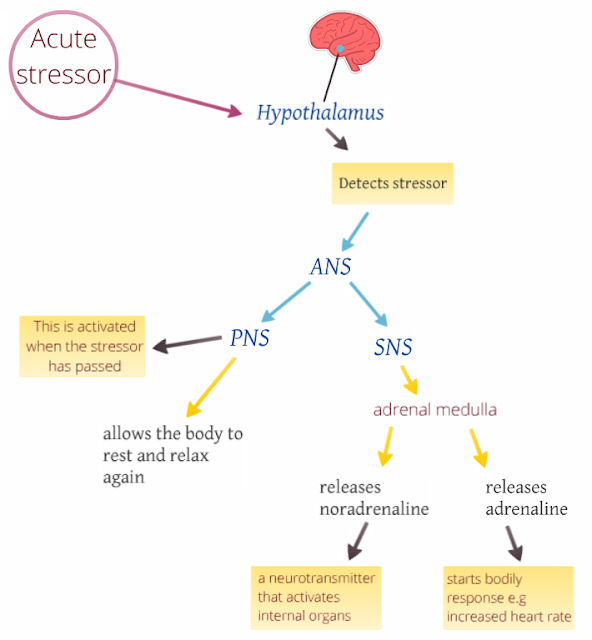Aim:
To investigate the capacity of short term memory
Method:
- Participants counted a number of dots flashed onto a screen
Results:
- Participants could recall about 7 items
- Participants would recall the same number of items for letters/numbers/words
Conclusion:
- Short term memory holds 7±2 items
- People chunk things together in order to retain more information
Evaluation:
- A variety of studies show that short term memory is limited to just 4 chunks
- Cowan (2001)
- When tested on purely visual information it was found that 4 items were the limit
- Vogel et al. (2001)
- Simon (1974) found that the size of the chunks affect the capacity of STM
- Larger chunks (such as phrases) mean a shorter span
- Smaller chunks (such as letters) mean a longer span
Thursday, 14 March 2013
Wednesday, 13 March 2013
The body's response to stress
Monday, 11 March 2013
The body's response to chronic stress
Chronic stress is stress caused by a ongoing or long-term stressor. The body responds to this when the Hypothalamus releases corticotrophin-releasing factor into the bloodstream. The pituitary gland receives the CRF and releases adrenocorticotrophic hormone into the bloodstream also. ACTH is then recieved by the adrenal cortex which releases cortisol. Cortisol causes several changes to the body such as:
- A burst of energy: used to replace the body's initial burst of energy to the stressor
these physical changes would have been a survival advantage when a mammal faced immediate danger.
other bodily changes would be:
- Lowered immune response: a disadvantage of cortisol
- High blood pressure: a disadvantage of cortisol
Here is a basic summary of what steps the body takes in order to produce adrenaline and enable these bodily responses to take place:
CRF: Corticotrophin-releasing factor
ACTH: Adrenocorticotrophic hormone
Sunday, 10 March 2013
The body's response to acute stress
Acute stress is stress caused by a sudden or short-term stressor. The body responds to this when the SNS releases adrenaline into the bloodstream. Adrenaline causes several changes to the body such as:
- Dilated pupils: Allows more light into the eye to aid vision
- Increased heart rate: Increased blood flow to skeletal muscles
- Bronchial tubes dilate: Increased oxygen intake
- Glycogen stored in liver converted into glucose: Provides more energy
these physical changes would have been a survival advantage when a mammal faced immediate danger.
Here is a basic summary of what steps the body takes in order to produce adrenaline and enable these bodily responses to take place:
ANS: Autonomic Nervous System
SNS: Sympathetic Nervous System (Prepares the body for the 'fight or flight' response)
PNS: Parasympathetic Nervous System (Stimulates the 'rest and digest' response)
Saturday, 9 March 2013
Peterson and Peterson (1959)
Aim:
To investigate the duration of short term memory
Method:
- they enlisted 24 students attending their university
- they used a consonant syllable and 3 numbers (e.g. WRT 637)
- this was done so that they were not meaningful/memorable
- participants were asked to count backwards for intervals of time
- prevents rehearsal of the syllable
- they used different retention intervals (e.g. 3, 9, 12, 18 seconds)
Results:
- 90% could recall after 3 seconds
- 2% could recall after 18 seconds
Conclusion:
the duration of short term memory is 20 seconds max
Evaluation:
- the participants knew that they needed to recall after a period of time
- Marsh et al. (1997)
- participants were not expecting to recall they forgot the syllable after 2 seconds
- suggests that STM is much shorter
- Peterson and Peterson were only studying one type of memory
- words and syllables
- real-life scenarios differ and other types of memory are more frequently used
- remember faces/events
- validity - mundane realism
To investigate the duration of short term memory
Method:
- they enlisted 24 students attending their university
- they used a consonant syllable and 3 numbers (e.g. WRT 637)
- this was done so that they were not meaningful/memorable
- participants were asked to count backwards for intervals of time
- prevents rehearsal of the syllable
- they used different retention intervals (e.g. 3, 9, 12, 18 seconds)
Results:
- 90% could recall after 3 seconds
- 2% could recall after 18 seconds
Conclusion:
the duration of short term memory is 20 seconds max
Evaluation:
- the participants knew that they needed to recall after a period of time
- Marsh et al. (1997)
- participants were not expecting to recall they forgot the syllable after 2 seconds
- suggests that STM is much shorter
- Peterson and Peterson were only studying one type of memory
- words and syllables
- real-life scenarios differ and other types of memory are more frequently used
- remember faces/events
- validity - mundane realism
- they were not testing the duration
- the counting backwards cause the participants to displace the syllable rather than simply preventing rehearsal
- the counting backwards cause the participants to displace the syllable rather than simply preventing rehearsal
Subscribe to:
Comments (Atom)

